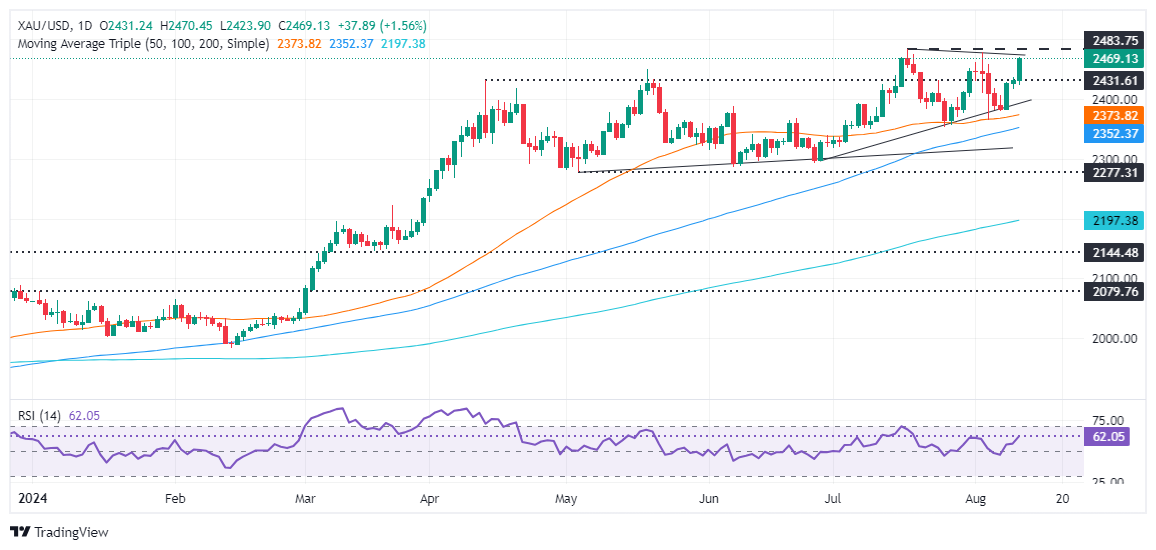Gold prices surge as US yields fall amid growing geopolitical tensions

- Gold surges 1% as US Treasury yields retreat ahead of key CPI data, with the 10-year yield down to 3.902%.
- Ongoing tensions in the Middle East, with no ceasefire in sight, drive demand for Gold’s safe-haven status.
- Traders await critical US inflation and Retail Sales reports with Fed commentary signaling cautious optimism on disinflation.
Gold price rallied over 1% on Monday during the mid-North American session as US Treasury bond yields retreated ahead of a busy economic calendar in the United States. Traders are bracing for the latest Consumer Price Index (CPI) report for July, which is expected to show an improvement in the disinflation process. The XAU/USD trades at $2,467 after bouncing off a daily low of $2,423.
Sentiment shifted sour amid ongoing developments in the Middle East. Israel, Lebanon and Iran’s lack of efforts to reach a ceasefire agreement kept market participants uneasy. This triggered a flight to Gold’s safe-haven status due to a possible escalation of the conflict.
US Treasury bond yields edged lower with the 10-year benchmark note rate down four basis points (bps) to 3.902%, ahead of the release of inflation data.
In the meantime, Federal Reserve Governor Michele Bowman was neutral, contrary to her usual hawkish posture and said that some progress on inflation is welcome, according to data from the last two months.
During the week, the economic docket will feature the release of US inflation figures on Tuesday and Wednesday, followed by Retail Sales data on Thursday and Friday’s University of Michigan (UoM) Consumer Sentiment.
Daily digest market movers: Gold price soars ahead of US data release
- July’s Producer Price Index is expected to drop from 0.2% to 0.1% MoM.
- The Consumer Price Index (CPI) is estimated to drop from 3% YoY to 2.9%; core CPI is expected to continue its downtrend from 3.3% to 3.2% YoY.
- Economists expect a jump in US Retail Sales from 0% to 0.3% MoM.
- The golden metal price gathered traction despite reports that China’s central bank restrained itself from purchasing Gold for the third consecutive month.
- The CME FedWatch Tool shows the odds of a 50-basis-point interest rate cut by the Fed at the September meeting at 47.5%, down from 52.5% last Friday.
Technical analysis: Gold price advances past $2,450
Gold’s uptrend extended on Monday, with prices approaching the $2,470 figure ahead of the all-time high (ATH) of $2,483, which could be tested if inflation comes lower than foreseen. Momentum favors buyers, as reflected by the Relative Strength Index (RSI), which is above the neutral line aiming higher.
The buyer’s first resistance would be the ATH. Once cleared, the next challenge would be to clear the psychological figure of $2,500. Further gains are seen above that level, with $2,550 being next, followed by $2,600.
Conversely, if XAU/USD drops below $2,450, the next support would be $2,400, followed by the 50-day Simple Moving Average (SMA) at $2,373. Once surpassed, the decline could intensify, leading to the 100-day SMA at $2,352, followed by a support trendline around $2,320.
Inflation FAQs
Inflation measures the rise in the price of a representative basket of goods and services. Headline inflation is usually expressed as a percentage change on a month-on-month (MoM) and year-on-year (YoY) basis. Core inflation excludes more volatile elements such as food and fuel which can fluctuate because of geopolitical and seasonal factors. Core inflation is the figure economists focus on and is the level targeted by central banks, which are mandated to keep inflation at a manageable level, usually around 2%.
The Consumer Price Index (CPI) measures the change in prices of a basket of goods and services over a period of time. It is usually expressed as a percentage change on a month-on-month (MoM) and year-on-year (YoY) basis. Core CPI is the figure targeted by central banks as it excludes volatile food and fuel inputs. When Core CPI rises above 2% it usually results in higher interest rates and vice versa when it falls below 2%. Since higher interest rates are positive for a currency, higher inflation usually results in a stronger currency. The opposite is true when inflation falls.
Although it may seem counter-intuitive, high inflation in a country pushes up the value of its currency and vice versa for lower inflation. This is because the central bank will normally raise interest rates to combat the higher inflation, which attract more global capital inflows from investors looking for a lucrative place to park their money.
Formerly, Gold was the asset investors turned to in times of high inflation because it preserved its value, and whilst investors will often still buy Gold for its safe-haven properties in times of extreme market turmoil, this is not the case most of the time. This is because when inflation is high, central banks will put up interest rates to combat it. Higher interest rates are negative for Gold because they increase the opportunity-cost of holding Gold vis-a-vis an interest-bearing asset or placing the money in a cash deposit account. On the flipside, lower inflation tends to be positive for Gold as it brings interest rates down, making the bright metal a more viable investment alternative.
